ONLINE KONKAN INFORMATION GUIDE
Chiplun and Guhaghar
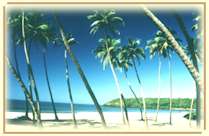
On the highway to Goa, about 300 km from Bombay is Chiplun, once a quiet glorified village, but now awakening to a larger role with the coming up of the Konkan Railway line and a new railway station. About 40 km directly west of Chiplun is the coastal village of Guhaghar with a picturesque stretch of sand. But itís not the beach that is the highlight of the place. After reaching Guhaghar, if you havenít seen Anjanvel already, turn due north and head for the villages of Anjanvel and Veldur at the mouth of the Vashishti River opposite Dabhol. The road climbs up the hilly coastal slopes and offers panoramic views of the area around. When you start seeing signs of construction indicating that you are at the much-talked about Project Site, look for the track that will take you to Anjanvel. The last half a km or so is a very steep slope and engaging first gear is advised. Also look out for any bus coming up the other way with no intention of stopping on the slope. Park your vehicle near the foot of the ruined fort of Gopalgarh or get down from the bus at the makeshift bus stop. Scamper up the slope through the village to the battlements of the fort. As you emerge through the trees and fields, and negotiate the final gentle plateau, a breathtaking view of the sea dashing itself on the rocks below awaits you. The ramparts of the ruined fort snaking downwards right up to the sea, the cliff face to the south as it reaches out into the sea and the lighthouse with two ancient temples at the end of it, completes a truly stunning sight. The gentle chugging of a passing fishing trawler only adds to the sounds of silence. I fervently wish that the construction of the Project nearby does not, in any way, disturb this pristine scenery.
To get to the lighthouse, you can take the paved footpath, which is now only barely discernible, just above Anjanvel. A more scenic walk would be to reach the south-western part of the fort where the fort walls meander down to the sea and then turn left and walk along the edge of the cliff till you reach the lighthouse. Like all other lighthouses in the area, this one occupies a commanding position with terrific views both to the north and south. The temples outside the gates of the colony are now renovated and only an old pillar stands to tell you that it really was ancient. The light keepers are friendly folk and you should not find any problem in climbing up the tower with their permission. On a holiday you are likely to encounter people from the Project Site.
I found an old couple in the village of Guhaghar who offered me their spare room to bunk for the night and a lodge nearby that tanked up my belly with Ė you guessed it Ė fish and rice. Otherwise there are some other places where you can put up for the night. On my last visit I found that the various people working on the Project have taken up most of the available lodgings at Guhaghar and Dabhol. So accommodation might be a little hard to come by.
Guhagharís beach is definitely worth a visit. Itís a wide expanse of white sand set in a gentle curve of the coastline. To get to the beach, if youíre on foot, just take any footpath that goes west from the villageís solitary road and a short walk through some coconut plantations should soon find you treading sand and hearing surf break. To take your vehicle to the beach, ask for the PWD Government Rest House. Its on the beach and thereís a small road that will allow you to take your vehicle on to the beach. Early evening on a full-moon night on the beach is an exhilarating experience. There are no artificial lights at all to dazzle your vision. The sky, if it is cloudless, is ablaze with stars and after a while the Milky Way also begins to become discernible. The rising moon behind you ensures high tide and pounding surf. The regular sweep of the beam of the lighthouse at Tolkeshwar from the north adds to the aura and mystery of the night.
At Guhagar we found Hotel Kautilya - Ph:- (02359) 40203 where one could stay during visit to this part of the coast. The rooms were pretty comfortable and some were even air conditioned. The hotel is at the southern end of the town on the single road that runs through it.
Velneshwar,to the south of Guhaghar is also worth a visit if you have the time. But itís not an out of the way place and you are likely to find a crowd over there. If on your own or with only a two-wheeler, this is also the direction to head for if you want to cross over to the next portion of the coastline. You may find the ferry services either at Hedvi or at Velneshwar itself. 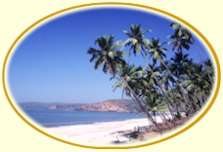

Hedvi
Hedvi is a small village that is spread out over a largish area behind a small beach. The highlight of the beach is the grove of coconut trees and the small temple at the bottom of the hill to the north of the beach. The temple has a convenient fresh water spring just outside the entrance and its located just right to "shower" down after a romp in the sea. The sand, however, is slightly dark but that does not mar the beauty of the beach and its exclusivity. Also conveniently located is a "beach house" bed and breakfast place belonging to one Mr Abhay Bhatkar. He has erected some huts at the rear of the beach and his more "pucca" hut is located a further 50 yards behind. You can drive upto this place and park your car in his porch. Mr Bhatkar lets out this place. A year ago it cost us Rs 200. With a sumptuous dinner with fish and a generous breakfast the next morning for three put us back by only Rs 175. To get in touch with Mr Bhatkar you can call him at (02359) 43208 or 43209. He calls his place "Suruchi Corner". Toilet and bath facilities are extremely basic and have to be shared with others, if any.
Ganpatipule & Bandarphule.
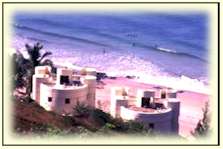
The road from Hathkhamba towards Ganpatipule, crosses over one of the longest tunnels on the Konkan Railway line. The road ends at this temple resort quite spectacularly when it climbs down a steep hill with a magnificent view of the ocean. We once approached it just as dusk was beginning to set. There was a slight nip in the air, and the sun had just disappeared below the horizon. All these factors combined together lit up the scattered clouds above us and coloured them in glorious shades of orange and red. At one point we were so distracted by this celestial drama that I almost drove off the road. Ganpatipule is truly a fabulous beach but it has been colonised by hotels, both private and those belonging to the Maharashtra Tourism Dept. People come here not only to enjoy the sea but also to pray at the temple of Lord Ganesha, which is located inside a hill. To pay obeisance to the God inside, pilgrims have to circle the entire hill, for which a paved footpath has been provided.
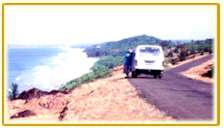

At any given time, Ganpatipule is crowded and during the holiday season it is next to impossible to get accommodation in any of the hotels around. We suggest you spend minimum time here and instead head for the neighbouring beach at Bandarphule. Itís just a couple of kilometres south from Ganpatipule and any body will show you the road to it. Otherwise follow the signs for KRISHNALI RESORTS. The road goes up and then down and literally hugs the hillside. At one point, right at the top, you can get good views of both the beaches at the same time. This beach is left alone by the crowds at Ganpatipule and if you have money to spare you can relax in one of the restaurants of the rather up-market KRISHNALI RESORTS that has recently come up just behind the beach.
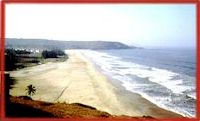
How to Get There :-
Direct By Rail : Take the KONKAN RAILWAY either at Bombayís Victoria Terminus (VT), now known as Chhatrapati Shivaji Terminus (CST for short) or at any of the stations en route if you are already on the road.
Disembark at Sangameshwar and take a bus to Ganpatipule.
Places to Stay :-
For stay at Ganpatipuleís MTDC hotel, (Direct Phone Numbers Ė 02357-35248,35061,35062, Fax Ė 02357-35328) the best bet is to do your booking at Bombay before you embark on your journey. It has rooms, suites and independent bungalows to cater for all tastes. But being government run they are full of free-loaders especially during holiday season. The advantage is that it is right on the beach and you can literally step out from your room onto the sands. There are privately run hotels that have better facilities and restaurants. But since they were built after the restriction on building near the beach came up, they are located slightly away from the beach and getting to the water line involves a short hike or drive from your room. The Resort at Bandarphule, however, is built just behind the beach. Perhaps the fact that it belongs to a local political big-wig may have something to do with it. Available phone numbers are given here.

HOTEL LANDMARK, Ganpatipule,
Tel Ė (02357) 35284 (4 lines) (Direct) or (022) 6235250,6235327 (Bombay Contact Ė 11.00 a.m. to 7.00 p.m.)
KRISHNALI BEACH RESORT, Bandarphule,
Tel - (02352) 35330,35352 (Direct) or (022) 3860918/3822999, Fax: 91-22-3823368 (Bombay Office)
Ratnagiri
Ratnagiri is further south on the coast from Ganpatipule. To get to Ratnagiri direct from Ganpatipule see above. There is nothing to write home about Ratnagiri. Itís a large town and again gaining importance because of the Konkan Railway and the new railway station. Itís also the place to head for if you cannot find accommodation at Ganpatipule and are dying for a comfortable place to stay. 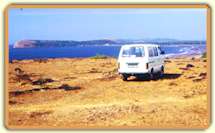
Ratnagiri has its own beach resort at a place called Bhatya, just south of the creek by the same name. The State Govt. Tourism Department runs a Tent Colony here. To get there ask for the road to Pawas, and exit the town from the south. Cross the bridge across the creek and you are at Bhatya. You can see the tents pitched inside a grove of casurina trees. To get a flattering view of the town, continue further south on the road and after it climbs the cliff bordering the southern end of the beach, get off the road to the right. The textured sands of Bhatya beach below, the creek beyond, a solitary lighthouse on a whale backed feature jutting out into the sea and a portion of Ratnagiri town behind it on green slopes is a view worth enjoying for some time whilst you brew some tea or coffee. Sitting there we wondered why it has not formed part of any Maharashtra Tourism poster. Itís that good. Reservations for the tent colony at Bhatya beach are also available at any local MTDC office or at their Bombay Office.
Places to Stay :-
Ratnagiri has hotels and lodges to cater to all pockets. Itís not a big place and asking around in the town should get you to a good place that should suit you. With industries, their offices and an airport coming up as also with the new railway station, Ratnagiri is no longer a remote town that it once was approachable only by road. Therefore, hotels to cater to even up-market tastes have sprung up in town.

Purnagad and Pawas
South of Ratnagiri has been declared as an industrial zone for small and medium scale industries by the government. Therefore the road that leads south of Bhatya beach up to Pawas and beyond to Purnagad is scattered with factories and their colonies. There is not much scenery to enjoy and the road runs about a kilometer inland than it should. At Pawas creek itself, Finolex Cables has put up a huge jetty for their factory that is located just above. Pawas is a place of religious significance to Hindus and at any given time you are likely to encounter a lot of pilgrims at the couple of ancient temples that are located here. Pawas itself is not on the coast and to get to Purnagad, continue on south on the road for a nother 15 km or so.
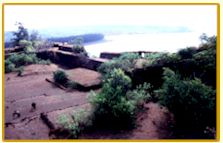
There are a couple of rough unpaved roads that go west from this stretch to Purnagad and lead to the few villages that are located north of Purnagad. I once made my way to one of these villages and then walked along the coast towards the south to Purnagad creek. It was a 6km walk and I really enjoyed myself for the three leisurely hours that it took me to complete it. The sea was a bit rough as it was during the monsoons and my only companions were the constantly pounding surf to the right and the breeze trying desperately to blow my hat away. As you near Purnagad, you encounter a paved bridle path somewhat obliterated now with age. The fort is located high above on the left and if you donít look out for it, you are likely to miss it.
On our last visit, however, we drove all the way to Purnagad. The road ends at the mouth of the creek just below the new bridge which has been completed sometime during the first week of December 1998. It is now possible to drive all along the coast from Ratnagiri upto Purnagarh and beyond upto Adivre and then link back to the National Highway 17 at Rajapur. To get to the mini-fort from here, get to the end of the road that is marked by an old temple, now gaily painted with bright colours. You are likely to find the local boys playing cricket in the compound. From here go through the village which is situated on the slopes and has only footpaths going from hut to hut. Ask the villagers the way to the fort as you proceed since there are simply too many paths going in all sorts of directions. It takes about 20 minutes of continuous walking through the village to get to the fort. Once there, you will find no one but cows grazing inside. A good place to camp for a while, while enjoying your drinks and munchies as you savour the view of the coast further to the south.

CLICK HERE FOR INFORMATION ABOUT KONKAN CULTURE







